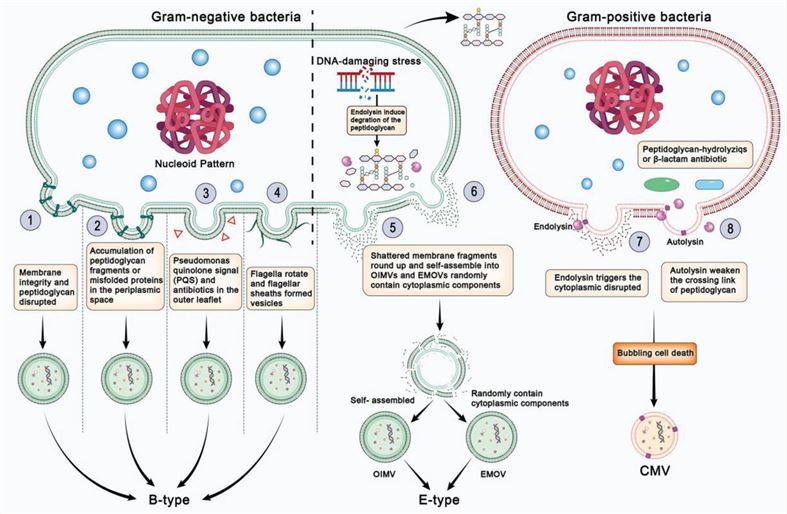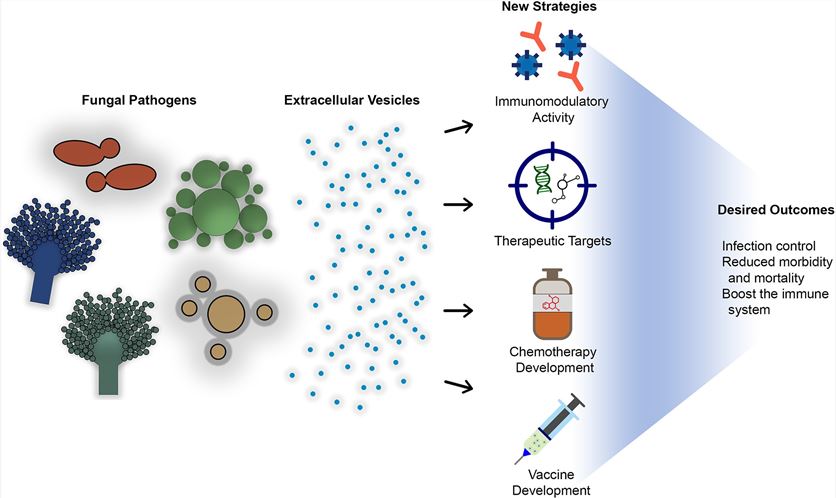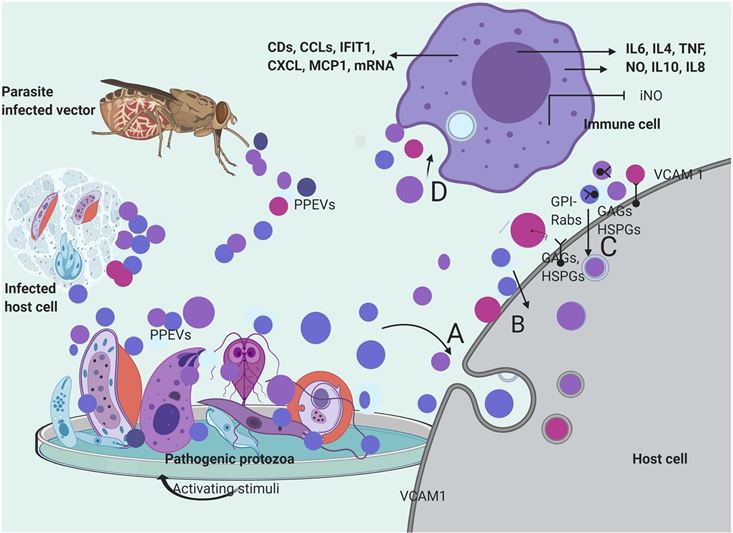Microbial Exosomes
Not only mammalian cells and plant cells can produce exosomes, but microorganisms can also produce exosomes. A large number of studies have found that bacteria, fungi, and protists release exosomes. Creative Biolabs has been committed to exosome research and can provide customers with microbial exosome extraction and downstream services.
Bacterial Exosomes
Different species of bacteria release exosomes that contain specific cargo molecules and have multiple functions in different ways. Gram-negative bacteria can release outer membrane vesicles (OMVs), outer-inner membrane vesicles (OIMVs), and explosive outer membrane vesicles (EOMVs). OMVs, consisting of a single membrane, arise from blebbing of the outer membrane resulting from envelope disturbance in Gram-negative bacteria. Phages can cause explosive lysis of Gram-negative bacteria. The resulting bacterial fragments can aggregate and self-assemble into OIMVs and EOMVs. Phages can also cause blebbing of Gram-positive bacteria, during which Gram-positive bacteria produce cytoplasmic membrane vesicles (CMVs).
 Fig.1 Schematic diagram of different biogenesis of bacterial membrane vesicles.1,4
Fig.1 Schematic diagram of different biogenesis of bacterial membrane vesicles.1,4
Bacterial exosomes can be isolated from the supernatant of bacterial cultures by ultrafiltration plus centrifugation, immunoaffinity chromatography, and detergents. Detergents, including lysozyme, can remove endotoxins from bacterial exosomes and improve biocompatibility. Bacterial exosomes have been shown to play key roles in pathogenesis by delivering certain biomolecules to host cells. In addition, bacterial exosomes are not easily degraded by enzymes and are easily functionalized. Bacterial exosomes can be loaded with a range of drug types. At present, studies have found that some bacterial exosomes can be used as antibiotic delivery vehicles and vaccines to treat bacterial infections, which is expected to combat the growing problem of antibiotic resistance.
Fungal Exosomes
Similar to the mechanism by which mammalian cells release extracellular vesicles, fungi have also been reported to release exosomes, membrane vesicles (MVs), and periplasmic vesicles (PVs). At present, fungal exosomes are mainly extracted from fungal culture supernatants by differential centrifugation, ultracentrifugation concentration, density gradient centrifugation, and size exclusion chromatography. The release of fungal exosomes plays a key role in pathogenesis and symbiotic relationships. For example, increased exosome release from C. neoformans cln1 mutants was accompanied by increased sterol content and enhanced virulence, suggesting an active role of fungal exosomes in the regulation of virulence. P. brasiliensis-derived exosomes can promote M1 polarization and proinflammatory factor production in mouse macrophages. Conversely, H. capsulatum-derived exosomes can inhibit macrophage phagocytosis, thereby promoting H. capsulatum survival and persistent infection. Based on the above-mentioned role of fungal exosomes, fungal exosomes are expected to be used in the treatment of diseases caused by fungal infections.
 Fig.2 Fungal EVs may play a pivotal role in the establishment of fungal infections and can alter the infection process.2,4
Fig.2 Fungal EVs may play a pivotal role in the establishment of fungal infections and can alter the infection process.2,4
Protozoa-derived Exosomes
Some protozoa (also called parasites), such as Leishmania, Plasmodium, Toxoplasma, etc., can infect humans and cause diseases. Similar to mammalian cells, protozoa can secrete multiple types of vesicles, including exosomes, extracellular bodies, and tubules. Protozoa-derived exosomes can be extracted from the culture supernatant by conventional exosome extraction methods. Interestingly, protozoa-derived exosomes can be combined with protozoa and interacting mammalian cells. Parasite-derived exosomes have been shown to induce modifications in uninfected neighboring cells in host-parasite interactions or serve as antigen presenters for the immune system. For example, the internalization and intracellular survival of Leishmania in human macrophages are dependent on chaperone protein 10 (CPN10), which is present in Leishmania-derived exosomes. Leishmania-derived exosomes may promote host pathogenesis by promoting the expression of pro-inflammatory factors in host immune cells. Therefore, parasite-derived exosomes have great application prospects as drug delivery vehicles and vaccines for the treatment and prevention of parasitic diseases.
 Fig.3 Secretion and mechanisms of parasitic protozoan EVs internalization.3,4
Fig.3 Secretion and mechanisms of parasitic protozoan EVs internalization.3,4
Creative Biolabs can extract exosomes from culture supernatants of bacteria, fungi, as well as parasites and provide downstream purification, identification, engineering, and validation services. If you have microbial exosome extraction and research needs, please do not hesitate to contact us.
References
-
Gan, Y.; et al. Bacterial membrane vesicles: physiological roles, infection immunology, and applications. Advanced Science (Weinheim). 2023, 10(25):e2301357.
-
Freitas, MS.; et al. fungal extracellular vesicles as potential targets for immune interventions. mSphere. 2019, 4(6).
-
Olajide, JS.; Cai, J. Perils and promises of pathogenic protozoan extracellular vesicles. Frontiers in Cellular and Infection Microbiology. 2020, 10:371.
-
under Open Access license CC BY 4.0, without modification.
For Research Use Only. Cannot be used by patients.
Related Services:

 Fig.1 Schematic diagram of different biogenesis of bacterial membrane vesicles.1,4
Fig.1 Schematic diagram of different biogenesis of bacterial membrane vesicles.1,4
 Fig.2 Fungal EVs may play a pivotal role in the establishment of fungal infections and can alter the infection process.2,4
Fig.2 Fungal EVs may play a pivotal role in the establishment of fungal infections and can alter the infection process.2,4
 Fig.3 Secretion and mechanisms of parasitic protozoan EVs internalization.3,4
Fig.3 Secretion and mechanisms of parasitic protozoan EVs internalization.3,4









